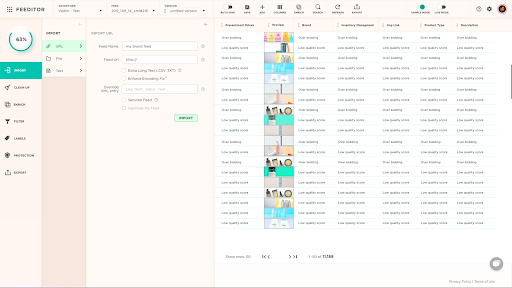What Is a Product Feed & How to Manage It?
In e-commerce, a product feed, also known as Data Feed, is a file or collection of files that contain a list of all your products and the products’ information. You can use this product feed, which is an online file, to send all the information about your products to multiple platforms such as Google, Facebook, and many other shopping websites.
If you deal with a large quantity of products or want to have those products for sale on many different platforms, it’s essential to use an automated product feed. With smart product feed management, power sellers can develop a competitive advantage, especially over sellers that do not use them.
After reading this article, you will understand what a product feed is, how to create one, and which tools to use to automate your feed creation and optimization.
What Is a Product Feed & How to Manage It?
What Is a Product Feed?
A product feed is a list of files with products and their information. Retailers use these feeds to add their products to online shopping platforms, markets, and social e-commerce shops use this data to showcase retail product listening. A product feed can be created in several file formats, including CSV, TXT, and XML files.
Google Shopping, Microsoft, and social media sites use these product feeds uploaded by e-commerce merchants. With product feeds, various shopping sites can show products, and retailers can save time by not needing to manage products on several channels individually.
Why Is a Product Feed Important?
Product feeds matter because they let retailers and marketers share their wares on several channels. More channels equal more eyes on their products.
By featuring products on several websites, marketers and retailers can find the channels that work best for them. They can remove products from sites that don’t convert while adding more to popular shopping destinations.
Digital markets use product feeds to save money on their sales campaigns. An effective and optimized product feed will help you find your target audience more easily, so you don’t have to advertise as much or pay for non-converting clicks. Adding keywords, descriptions, and metadata can help make your product feeds successful in campaigns.
You can read more about the practical ways to optimize your product feed to increase the relevance of your products and eventually sell more.
What Does a Product Feed Look Like?
A product feed will look like a list of information or a product description, often accompanied by an image of the product itself.
Product feeds can include:
- Product name
- ID or SKU number
- Color
- Price
- Size
- Stock status

How Do You Create a Product Feed?
To create a product feed, you will need all the appropriate information about your product.
There are three methods you can use:
- Manual creation
- Shop platform systems
- Feed creation tools
Things to Note About Product Feeds
While product feeds can make selling more convenient on various channels, they can also become overwhelming for business owners who do not track their feeds.
Most product feeds do not have information about optimization, so retailers need to manage the SEO and metadata for each site.
Business owners need to manage the product information to keep their lists accurate and their customers happy.
What is Product Feed Management?
To manage your product feeds, you must administer them to your chosen shop platforms and optimize them for the best performance. You can submit each feed manually or use an automatic method to distribute them to multiple platforms at once.
You can also track your feeds’ progress to understand how to improve their optimization.
Tips for Product Feed Success
Before arranging a product feed, businesses need to decide how to manage the data. It’s helpful to have a plan before uploading the feed to platforms. Consider using third-party apps to skip the back and forth work with developers and repetitive manual work.
Feed Automation Tools
Several companies offer feed automation tools that are designed to help retailers with complex or repetitive actions with their product feeds. Adcore offers a product feed app called Feeditor. With the Feeditor features, marketers and retailers can improve their sales performance. By getting products into the Feeditor, businesses can expand their reach by advertising to shoppers on Google, Amazon, and other popular global shopping sites. Shoppers can make purchases using any currency.
Using Feeditor removes the need for a software developer because this product makes adding new items and changing file formats easy.
Feeditor allows marketers and retailers to change their feeds at any time. They adjust the items as their needs change, and they can alter them to meet the requirements of each e-commerce platform. With one convenient product feed management tool, retailers won’t have to worry about combining platforms and losing product details in several tools.
Main Takeaways
Product feeds give large and small businesses a tool to share their products on several shopping channels in the global marketplace. You can create a feed manually, using shopping platforms or feed creation and automation tools. An optimized feed will keep your data organized while promoting your products and product ads on the different shopping platforms.
Trending Articles
Get exclusive CMO tips that I only share with email subscribers.
Related Articles


